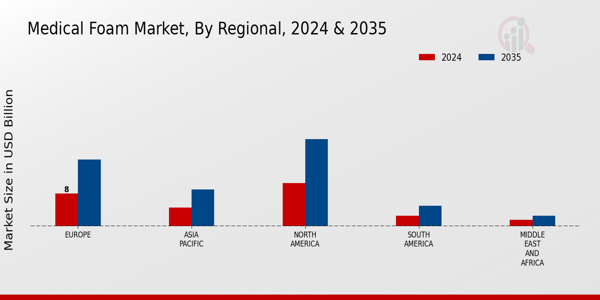Market Trends
Key Emerging Trends in the Medical Foam Market
The medical foam market is experiencing notable trends driven by advancements in healthcare technology, increasing demand for medical devices, and growing awareness of infection control measures. Medical foams, including polyurethane foam, silicone foam, and others, play a crucial role in various medical applications such as wound care, patient positioning, and cushioning in medical devices.
One significant trend in the medical foam market is the rising demand for foam-based wound care products. Foam dressings are widely used for managing wounds due to their ability to absorb exudate, maintain a moist wound environment, and provide cushioning and protection. With the growing prevalence of chronic wounds, such as diabetic ulcers and pressure sores, there is an increasing need for advanced wound care solutions, driving the demand for medical foams. Moreover, innovations in foam technology, such as the development of antimicrobial foams and foam dressings with enhanced properties, are further fueling market growth.
Technological advancements in medical foam manufacturing are driving market trends towards customized and specialty foam products. Manufacturers are investing in research and development to develop foam formulations with specific properties tailored to meet the requirements of various medical applications. For instance, there is a growing demand for high-density memory foams for patient positioning and support surfaces in hospitals and long-term care facilities. Similarly, bioabsorbable foams are gaining traction in surgical applications, offering temporary support and controlled drug delivery in tissue regeneration procedures.
The COVID-19 pandemic has accelerated market trends in the medical foam industry, particularly in infection control and prevention measures. Foam-based products such as foam swabs, wound dressings, and barrier foams are being used extensively in healthcare settings to reduce the risk of contamination and transmission of infectious diseases. Additionally, there is an increased emphasis on the use of antimicrobial and antiviral foam materials in medical devices and equipment to enhance patient safety and hygiene standards.
The aging population and the prevalence of chronic diseases are driving demand for medical devices and equipment, consequently boosting the medical foam market. Foam components are integral to the manufacturing of medical devices such as orthopedic supports, prosthetics, braces, and respiratory masks. As the global population ages and healthcare expenditure increases, there is a growing need for innovative and lightweight foam materials that offer superior comfort, durability, and performance in medical devices.
Environmental sustainability is emerging as a key trend in the medical foam market, driven by regulatory mandates and consumer preferences for eco-friendly products. Manufacturers are exploring bio-based and biodegradable foam materials derived from renewable sources as alternatives to traditional petroleum-based foams. Moreover, initiatives to reduce medical waste and carbon footprint are prompting healthcare facilities to adopt recyclable and compostable foam products in their operations. Sustainable foam solutions not only align with corporate social responsibility objectives but also contribute to mitigating environmental impact and promoting a circular economy in the healthcare sector.
Regionally, North America and Europe dominate the medical foam market due to the presence of established healthcare infrastructure, stringent regulatory standards, and high healthcare expenditure. However, the Asia-Pacific region is witnessing significant growth opportunities driven by rapid urbanization, improving healthcare infrastructure, and rising healthcare awareness. Countries like China, India, and Japan are investing in expanding their healthcare facilities and adopting advanced medical technologies, creating a conducive environment for market expansion in the region.













Leave a Comment